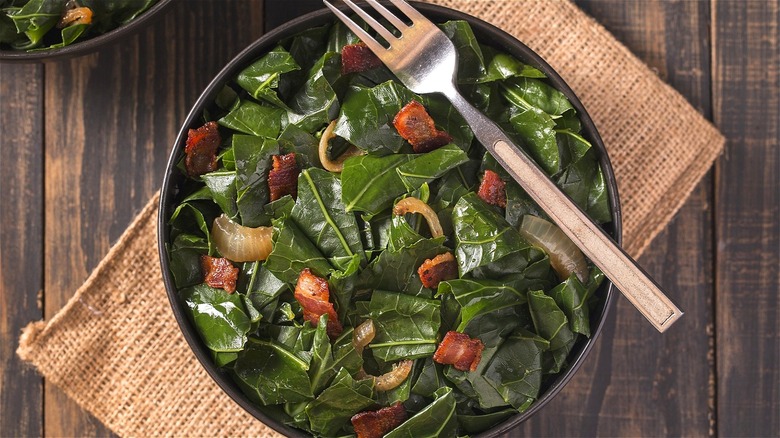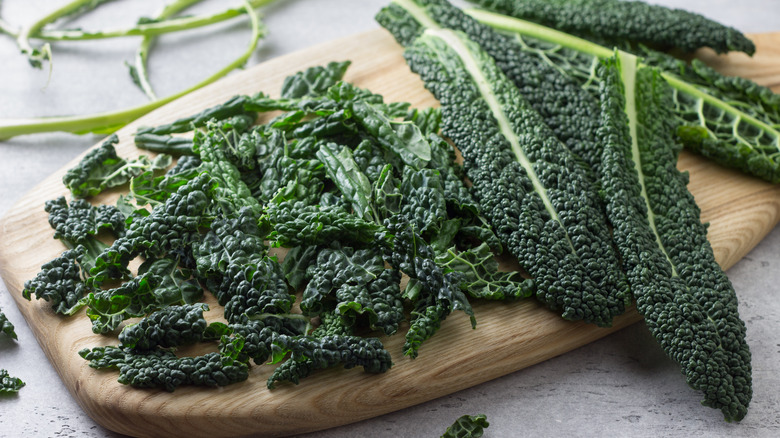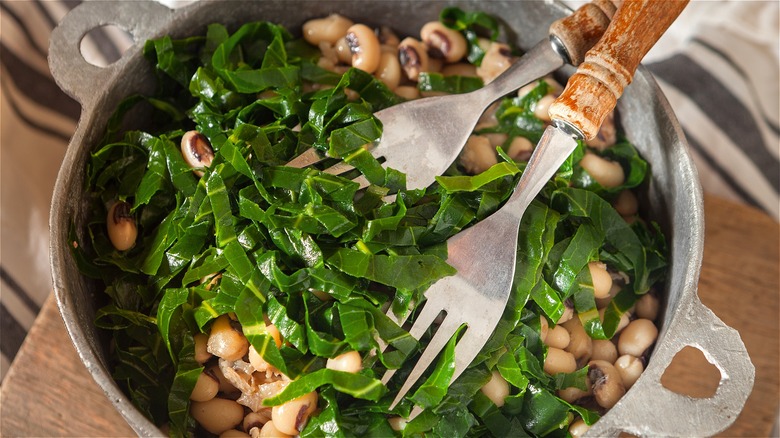The Most Important Step For Preparing Tender Collard Greens
Isn't it true that most of our favorite homestyle meals can be upgraded with delicious servings of sautéed greens? Whether preparing baked chicken or classic beef meatloaf, rounding out your meals with satisfying vegetable-based side dishes is always a good idea. Out of all the options to choose from, collard greens have been a Southern staple for decades. Often served with barbecued foods, macaroni and cheese, or freshly baked cornbread, collard greens provide hearty meals with a satisfying dose of added color and texture. Next to these positive attributes, Healthline says collard greens are also packed with antioxidants and essential nutrients such as vitamin K, calcium, and folate. Even though these dark green veggies have several health benefits, collard greens are categorized as cruciferous vegetables, like Brussels sprouts and cabbage, and impart a slightly sharp flavor to your palate.
If you've been wanting to whip up a side of collard greens but are concerned with your ability to cook these sturdier veggies until tender and delicious, first wash each bunch thoroughly in water and remove the hard central stem from each leaf. Like most varieties of kale, collard greens are much more easily enjoyed when their inner stems are removed before cooking. Now that you know the importance of detaching these pesky stalks, what's the quickest way to get the job done?
Wash and prep collard greens for ultra-tender veggies
After you wash and dry your collard greens, you can remove the inner stem from each leaf in a few different ways. The first and most convenient method requires no additional tools. If you're used to de-stemming kale, you already know the drill: Hold each leaf bottom side up, grip the leaves around the base of the stem, and pull straight down. You may have to pull off some missed pieces, but once you've developed some experience, this technique proves quite effective.
Alternatively, there is more than one way to remove collard green stems with a sharp knife. The safest way is to lay your collard leaves flat side down on a cutting board and remove the sides of each leaf by cutting them directly from the stem. You can simplify this process by folding your collard greens in half and cutting each leaf straight down along the stem line. For those who eat greens often, you may benefit from purchasing an herb stripper tool with various-sized holes. Whichever route you take in terms of preparation, de-stemming is an essential step when your ultimate goal is tender and delicious collard greens. Now that you know how to remove the stems from these hearty veggies, let's delve into a few tips when preparing collard greens at home.
How to make delicious collard greens
When you've successfully removed the stems from your collard greens, turn the leaves longways and cut them into long strips before cooking. The most classic way to prepare these nutritious greens is by incorporating some essential seasoning and cooking them long enough so that they transform into a tender, mouthwatering side dish. Since raw collard greens have a sharp flavor, when cooking, add enough salt and include a little acidity, such as vinegar, to balance out their resulting flavor. As far as cooking time goes, add your prepared greens to various meat-based dishes and braise them for up to two hours. Conversely, if you're after a tasty stand-alone side dish, quick bacony collard greens may be a recipe worth trying since the included greens only need to meld with the added bacon for 20 minutes before serving.
While there is more than one tasty way to prepare collard leaves, don't completely discount those forgotten stems. The stems of collard greens are a great way to provide additional flavor to homemade stock. These fibrous stems can also be used as an additional ingredient in your next batch of soup, or even used raw and blended into a homemade pesto. Even though removing collard stems may be recommended when preparing several side dishes, there are many tasty ways to enjoy collard greens in their entirety.


